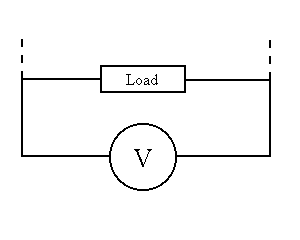
A multimeter is a device used to measure voltage, current, and resistance. The basic multimeter is shown in the figure below.

A standard multimeter is composed od a voltmeter, an ammeter, and an ohmeter. The one shown above denotes an analog multimeter. As you can see there are two major parts, the screen, which gives the reading, and a dial swicth, which allows you to select the type of reading to make. Another important part of the multimeter not shown in this figure are the two probes. Normally, the two probes are colored red and black. Red stands for positive and black for negative.
Set as an ohmeter, all you have to do is set the dial to the ohmeter setting, usually labeled by X??k, where ?? is a number. Then connect the two probes together. Then check to see if the neddle points to the zero at the right end. This scale is the one used for the ohmeter. If it is not set to zero, find the small dial labeled adj and turn in around until the needle points to the zero value. Then disconnect the two probes from each other and connect the probes to each end of the resistor. The actual resistance is the reading multiplied by the setting of the ohmeter. If the reading of the meter is 50 and the ohmeter is set at X10k, then the actual resistance is 50 * 10k = 500k ohms.
As an ammeter or to measure current, all you have to do is first set the to the ammeter's highest setting. This is for safety purposes because we do not want the current passing through it to be greater than the setting. Then connect the multimeter or ammeter in series with the load whose current we are measuring.

Once we have the multimeter in place, and the meter reads zero, we lower the ammeter setting or range until we reach a setting where the needle points somewhere in between zero and the maximum. Then we are ready to make a current reading. To read the actual current, we read the setting or maximum range of the ammeter. Then we find the correct scale on the meter screen. If the setting reads 250 micro amperes, we use the scale from 0 to 250. If the needle points to 50, then we have 50 micro amperes.
As a voltmeter, first select whether we are measuring ac or dc voltage. Then as usual, set the voltmeter to the maximum setting. The way the meter is read is pretty much the same as in the ammeter setting but the connection of the multimeter is different. To measure voltage, we must connect the multimeter in parallel with the load.

If we are using a digital multimeter, all we have to do is set the multimeter to the correct setting, whether voltmeter, ammeter, or ohmeter. Then we just connect it like in the analog multimeter. The correct measurement just appears at the display.